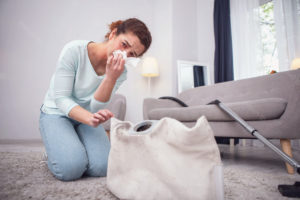 Having an allergic reaction to things in your home may affect you more than you would think, especially in the long-term. In this article we will talk about the most common allergies that might occur in your house, as well as what you can do to help yourself and reduce your symptoms.
Having an allergic reaction to things in your home may affect you more than you would think, especially in the long-term. In this article we will talk about the most common allergies that might occur in your house, as well as what you can do to help yourself and reduce your symptoms.
It is not uncommon for you to develop an allergy to something in your house. There are a number of things that might cause irritations, such as itchy and runny eyes, inflamed and swollen sinuses, coughing or skin conditions. The most common causes for those would be pets, mould and dust mites. Those can be found in every home, no matter the climate or location. It is not possible to completely rid your house of all allergens and maintain it perfectly clean. However, there are certain things that trigger allergies more than others, as well as steps you can take to reduce the amount of irritants. Keep reading to find those out.
Mould Allergy
Moulds live everywhere. That is why mould allergies occur over several seasons, if not all year round.
Mould and mildew are fungi. They reproduce by spores. Those spores travel through the air and while some of them spread with fog and dew, others prefer dry, windy weather.
It is very easy to inhale spores since they are so light and airborne. Inhaling those may actually cause allergic reactions in some people. Mould allergies are most common from July to early autumn. Fungi however, grow both inside and outside so allergic reactions might happen during the whole year.
Outdoor moulds grow on rotting logs, fallen leaves, grasses and compost piles. At home, bathrooms, kitchens and basements are favourite places for mould and mildew.
Symptoms: Mould allergy symptoms are very similar to hay fever ones. When the spores are inhaled they usually affect the throat and nose. However, it is not impossible for them to reach the lungs and trigger asthma.
In order to reduce mould at home: Use an asthma and allergy filter for your AC. Limit your indoor humidity, mold loves it so reducing it will also prevent it from growing. Dry and air your bathroom after showering. Treat mouldy areas as soon as they occur.
Pet Allergy
So many people have pets. However, pet allergies affect 10 to 20% of the world population. It is especially common for people who have other allergies or asthma to also experience allergic reactions caused by pets.
People are most often allergic to pets with fur, such as cats, dogs, guinea pigs, rabbits etc. Animals with feathers however, may also cause allergic reactions to someo people.
An interesting fact is that you are not actually allergic to your pet’s fur. The thing responsible for your irritation is the protein that is found in your pet’s dander, saliva and urine. What is more, fur and feathers collect dust mites, pollen and even mould. All dogs and cats cause allergic reactions – some breeds more than others. Anyways, there are no absolutely non-allergic pets.
Symptoms: Pet allergens usually land on the soft tissue around your eyes and mose. You may also breathe in pet allergens. Common symptoms would be hives, itchy throat, sneezing, stuffy or runny nose, swelling and itching of the eyes and nose.
In order to reduce pet allergens at home: Keep your pets out of bedrooms or places where you spend a lot of time in. Keep pets off fabric furniture, brush pets outside of your house (or ask someone without an allergy to do it for you). Change your clothes and shower after direct contact with pets.
Dust Mite Allergy
Everyone has dust mites at home. They are microscopic insects that live off human skin cells and form part of the dust in our homes.
Dust mite allergies are pretty common and most often affect people with asthma. Allergies are in fact triggered by dust mite droppings. Because dust mites are so tiny and airborne, it is unfortunately impossible to completely rid your house of them. There are things you can do to reduce the amount of mites however.
Symptoms: If you are allergic to dust mites, you may experience symptoms such as a runny nose, sneezing, blocked nose, itchy throat etc.
What to do to reduce the amount of dust mites at home: Regularly change and wash your bed sheets in hot water. Use synthetic pillows and acrylic duvets. Use a hypo-allergenic mattress cover. Air your bed every morning. Replace your carpeted flooring with wood or laminate one. Fit blinds that are easy to wipe instead of curtains. Dust your whole house at least once a week. Include vacuuming your upholstery and fabric surfaces in your weekly cleaning schedule.
As you can see, allergens can be found anywhere in your home. We hope that this article helps you pay more attention to the right places and manage to reduce the amount of allergy symptoms.
